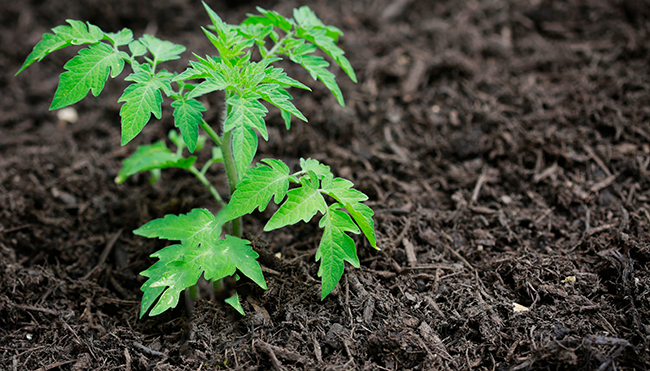
When to plant your tomatoes
In zones 4 and 5, it is generally recommended to wait until the end of May or the beginning of June to plant tomatoes in the ground. Why?
-
Risk of frost: Even if the days are warm, the nights can still be cool, with temperatures close to zero. Tomatoes, being native to tropical climates, are sensitive to frost and can be seriously damaged or even destroyed by freezing temperatures.
-
Soil still cool: The soil is not yet warm and drained enough to accommodate tomato plants. Soil that is too cold and wet can delay growth, promote the appearance of diseases and harm the survival of the plants.
When all risk of frost has passed and the soil is well warmed, install your tomato plants in a sunny spot in the garden
Where to plant your tomatoes
- Choose a sunny location - a minimum 6 to 8 hours of sunlight per day - sheltered from the wind.
- Before transplanting them into the ground, gradually acclimatize your plants to outdoor conditions by exposing them to a few hours of sun and wind each day for a week.
In open ground
Tomatoes thrive in soil with a high humus content that is light and well-drained, and ideally fertilized before planting. Plant tomatoes in the vegetable garden or integrate them into your flowerbeds; they are as decorative as they are delicious!
- Dig generous holes. Plants should be spaced 50 to 60 cm apart.
- Enrich it with two big scoops compost or well-rotted manure to provide the tomatoes with a nutrient-rich environment.
- Water thoroughly.
- Place the plant in the hole and fill with earth halfway up the plant. Tomato plants have the peculiarity of developing roots all along the stem when buried in earth.
- Water again thoroughly, at the base of the plants, avoiding wetting the foliage to limit the risk of disease.
- Put a 5 to 10 cm layer of straw around each plant to conserve soil moisture.
- Insert a clean and disinfected 1.5 m stake to support the plant.
- If you are planting rows of tomatoes, leave 80 cm between rows.
- In the vegetable garden, tomato plants do well alongside carrots, celery, cucumbers, onions, garlic, peppers, asparagus, radishes, mint, basil, parsley, sage and rosemary. Avoid planting your tomatoes next to cabbage, fennel, corn, beets, peas and potatoes.
In containers
Tomato plants do very well in rich, well-drained soil, which makes them suited to container growing, even on small balconies. A 60-litre container will be sufficient. Plants need to be sheltered from the wind in a location with lots of sunlight. Opt for determinate, compact bush varieties; indeterminate varieties, which are more robust and grow much higher, require a greater volume of earth than most containers can provide.
- Plastic or terra cotta containers: Darker coloured pots are preferable since they attract sunlight and the substrate will retain heat. Make sure there is a hole at the bottom so that water can drain.
- Containers with a water reserve and watering spike: These pots are ideal for plants requiring a great deal of water, such as tomatoes. The water reserves mean you can skip some watering, and the plants can make it through a heat wave.
- Smart Pots: Smart Pots are durable fabric containers ideal for growing everything just about anywhere. The geotextile bag allows roots to breathe and favours root aeration. Smart Pots promote root development.
- Thoroughly water the root balls of your plants.
- Wash and disinfect pots.
- In plastic and terra cotta containers, put a layer of gravel in the bottom to promote drainage. Containers with water reserves and Smart Pots do not require gravel.
- Tomatoes are nutrient-greedy plants, so fill containers with a mix of compost and soil rich in organic matter.
- Make a deep hole and add a fistful of tomato fertilizer. Insert the plant at an angle to cover a good part of the stem. Fill with soil. One tomato plant per container.
- Water thoroughly at the base of the plants, avoiding wetting the foliage to limit the risk of disease..
- Insert a stake.
- For pot companions, plant a few herbs or marigolds with the tomato plant. Basil seems to enhance the flavour of tomatoes.






